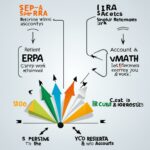Are you looking to teach your kids about investing? Whether they’re young children or getting ready for college, there are several great options for investment accounts for kids. Let’s explore the top choices available.
Key Takeaways:
- Investing for kids can teach them about financial literacy and set them up for long-term success.
- Custodial Roth IRAs allow parents to manage the account until the child reaches 18 or 21.
- 529 education savings plans offer tax advantages and flexibility for college savings.
- Coverdell Education Savings Accounts provide tax-free growth and withdrawals for education expenses.
- UGMA/UTMA custodial accounts offer flexibility for investment choices but have fewer tax advantages.
Custodial Roth IRA
A custodial Roth IRA is a fantastic investment option for kids who have earned income from a part-time job. As a parent or guardian, you can open this account on behalf of your child and manage it until they reach either 18 or 21, depending on the state. With a custodial Roth IRA, contributions can grow tax-free, providing a valuable lesson for your child about the benefits of long-term investing and compound interest.
One of the greatest advantages of a custodial Roth IRA is that the funds can be used for qualified education expenses without incurring penalties. This means that if your child decides to pursue higher education, they can tap into their custodial Roth IRA to cover tuition, books, and other educational costs.
Teaching kids the importance of saving and investing early on can set them up for a lifetime of financial success. A custodial Roth IRA offers the opportunity to instill these valuable lessons while also providing a tax-efficient way to grow their savings.
By starting a custodial Roth IRA for your child, you’re helping them build a solid financial foundation for their future. The tax advantages of this account can have a significant impact on the growth of their investments over time.
To put it into perspective, let’s compare the growth of a custodial Roth IRA with a traditional savings account:
| Account Type | Annual Contribution | Investment Return | Total After 18 Years |
|---|---|---|---|
| Custodial Roth IRA | $2,000 | 6% | $71,206 |
| Savings Account | $2,000 | 1% | $39,213 |
This table clearly demonstrates the potential for significant growth within a custodial Roth IRA compared to a traditional savings account. With a 6% investment return, a custodial Roth IRA can grow to over $70,000 in 18 years, while a savings account would only accumulate around $39,000 with a 1% interest rate.
Opening a custodial Roth IRA for your child is an excellent way to introduce them to the world of investing, secure their financial future, and potentially help them avoid student loan debt. Start early, contribute regularly, and watch as their investments grow over time.
529 Education Savings Plans
If you’re a parent looking for a college savings account for your child, 529 education savings plans are a popular and attractive option. These plans provide a tax-advantaged way to save for your child’s education expenses. With no contribution limits, they offer flexibility and potential for significant growth over time.
There are two types of 529 plans: prepaid tuition plans and education savings accounts. Prepaid tuition plans allow you to purchase college credits at today’s prices, providing protection against future tuition increases. On the other hand, education savings accounts allow you to invest your money in the market, potentially generating higher returns.
One of the key advantages of 529 plans is that withdrawals made for qualified education expenses are tax-free. This means that the earnings on your investments can grow without being taxed, as long as the funds are used for educational purposes. It’s a powerful way to maximize your savings and reduce the financial burden of college expenses for your child.
The tax advantages and flexibility of 529 education savings plans make them an attractive choice for parents looking to save for their child’s college education.
By starting early and consistently contributing to a 529 plan, you can build a substantial college fund for your child. These accounts are available in most states and can be used at eligible educational institutions across the country.
Comparing 529 Plans to Other College Savings Options
While 529 plans offer numerous benefits, it’s important to consider all your options when saving for your child’s college education. Here’s a comparison of 529 plans to other common college savings accounts:
| 529 Education Savings Plans | Coverdell Education Savings Accounts | UGMA/UTMA Custodial Accounts |
|---|---|---|
| No contribution limits | Maximum contribution limit of $2,000 per year per beneficiary | No contribution limits |
| Tax advantages for qualified education expenses | Tax advantages for qualified education expenses | Fewer tax advantages |
| Flexibility to invest in the market or purchase prepaid college credits | Wide range of investment options | Investment options include stocks, bonds, and mutual funds |
While each account type has its own advantages, 529 education savings plans provide the greatest flexibility and potential for tax-free growth. Consider your financial goals, risk tolerance, and specific needs when choosing the best college savings account for your child.
Coverdell Education Savings Accounts
When it comes to saving for your child’s education expenses, Coverdell Education Savings Accounts are another option to consider. These investment accounts are specifically designed to help you prepare for the cost of education.
Contributions made to Coverdell accounts grow tax-free, providing a valuable opportunity to accumulate savings over time. Additionally, withdrawals from these accounts are also tax-free when used for qualifying education expenses.
However, it’s important to note that there is a maximum annual contribution limit of $2,000 per beneficiary for Coverdell accounts. Higher-income households may have reduced contribution limits. While these accounts offer more flexibility compared to 529 plans, the contribution limits are stricter.
If you’re looking for an investment account that allows you to save specifically for educational purposes, a Coverdell Education Savings Account can be a suitable choice.
Take a look at the table below to see a comparison between Coverdell Education Savings Accounts and 529 plans:
| Feature | Coverdell Education Savings Accounts | 529 Plans |
|---|---|---|
| Tax-Free Contributions | Yes | Yes |
| Tax-Free Withdrawals for Education Expenses | Yes | Yes |
| Contribution Limit | $2,000 per year per beneficiary | No contribution limit |
| Flexibility | More flexibility | Less flexibility |
Comparison of Coverdell Education Savings Accounts and 529 Plans
As you can see, both Coverdell Education Savings Accounts and 529 plans offer tax advantages. However, the contribution limit is a key differentiating factor. While Coverdell accounts provide more flexibility, 529 plans have no contribution limits, making them suitable for those who plan on contributing higher amounts.
Ultimately, the choice between a Coverdell Education Savings Account and a 529 plan depends on your specific goals, financial situation, and preferences. Consider your child’s future educational needs and your own contribution capabilities before making a decision.
UGMA/UTMA Custodial Accounts
If you’re looking for investment accounts for minors that offer flexibility and control, UGMA/UTMA custodial accounts are worth considering. These trust accounts can be opened by parents or relatives on behalf of a child. As the custodian, you have the authority to manage the account until the child reaches the age of majority, which varies by state.
UGMA/UTMA accounts allow contributions from the custodian as well as other family members, making it a collaborative effort in building the child’s investment portfolio. The funds in the account can be invested in a variety of assets, such as stocks, bonds, or mutual funds. This enables you to create a diversified portfolio that aligns with your investment goals and risk tolerance.
While UGMA/UTMA accounts may not offer the same tax advantages as 529 plans, they come with other benefits. One significant advantage is the flexibility they provide. Unlike the restricted use of funds in 529 plans, once the child reaches adulthood, they gain control over the account and can utilize the funds for education or other purposes.
Benefits of UGMA/UTMA Custodial Accounts:
- Flexibility in managing investments
- Collaborative approach with contributions from family members
- Opportunity to create a diversified portfolio
- Control over the account transfers to the child once they reach adulthood
If you’re looking for a way to introduce your child to investing and provide them with financial tools for the future, UGMA/UTMA custodial accounts offer a versatile option.
“UGMA/UTMA custodial accounts provide flexibility and control, allowing parents or relatives to open trust accounts for minors.”

| Account Type | Key Features | Tax Advantages |
|---|---|---|
| UGMA/UTMA Custodial Accounts | Flexible and collaborative investment approach | Limited tax advantages compared to other accounts |
| 529 Education Savings Plans | Specifically designed for college savings | Tax-free withdrawals for qualified education expenses |
| Coverdell Education Savings Accounts | Education-specific investment accounts | Tax-free withdrawals for qualifying education expenses |
Brokerage Account
When it comes to teaching teens about investing, brokerage accounts designed specifically for them can be a valuable tool. These accounts give ownership to the child and provide the opportunity to invest in various financial instruments such as stocks, bonds, mutual funds, and exchange-traded funds (ETFs). While parents or relatives should closely monitor the account activity, allowing children to have their own brokerage account can be an excellent way to involve them in the world of investing and educate them about the stock market.
A brokerage account for kids allows young investors to learn firsthand about financial markets and gain exposure to different asset classes. It can help them develop important skills, such as analyzing investment opportunities, managing risks, and making informed decisions. By actively participating in managing their investments, teens can gain valuable knowledge and experience that will serve them well in the future.
Fidelity is one broker that offers a Youth Account, designed specifically for teens. This account provides access to a wide range of investment options, including fractional shares. Investing in fractional shares enables teens with limited funds to diversify their portfolios, even if they don’t have enough money to buy full shares of expensive stocks.
Benefits of a Brokerage Account for Teens:
- Ownership: Teens have genuine ownership of the account, fostering a sense of responsibility and ownership in their financial future.
- Education: Teens can learn about investing and personal finance through real-world experience, developing important financial skills along the way.
- Choice of Investments: Teens have the freedom to choose from an array of investment options, allowing them to explore different asset classes and investment strategies.
- Long-Term Perspective: Investing from a young age gives teens the advantage of a longer time horizon for their investments to grow and potentially compound over time.
- Financial Independence: Teens can start building their wealth and financial independence early, setting them up for a more secure future.
Opening a brokerage account for your teen can be an exciting and impactful way to introduce them to the world of investing. With proper guidance and supervision, a brokerage account can provide valuable financial education and help lay the foundation for their future financial success.
“A brokerage account for teens offers a hands-on way for young investors to learn about the stock market and gain practical experience managing their own investments.” – [Your Name]
| Benefits of a Brokerage Account for Teens |
|---|
| Ownership |
| Education |
| Choice of Investments |
| Long-Term Perspective |
| Financial Independence |
Contribute to a Brokerage Account
If you prefer to have more control over your child’s investments, you can open a brokerage account in your own name or use your existing brokerage account. Work out an investment budget with your child and choose investments together. Keep in mind that selling investments at a profit may incur capital gains taxes. While this option doesn’t offer the same tax advantages as retirement or education savings accounts, it provides flexibility in choosing investments and withdrawing funds.
By contributing to a brokerage account, you have the opportunity to teach your child about different investment options and the importance of long-term planning. Involving them in the decision-making process can help develop their financial literacy and decision-making skills. Together, you can research and analyze various stocks, bonds, mutual funds, and exchange-traded funds (ETFs) to build a diversified portfolio that aligns with your investment goals and risk tolerance.
Investment Decisions Made Together
Opening a brokerage account for your child offers the chance to make investment decisions as a team. By involving them in the process, you are teaching them valuable lessons about money management and the power of investing. It allows them to learn firsthand the risks and rewards associated with different investment options.
One approach is to start by discussing different investment strategies, such as growth investing or value investing, and explaining the potential risks and rewards of each. Research companies together, evaluate financial performance, and analyze market trends. This collaborative approach not only teaches them about investing but also strengthens their critical thinking skills.
“Investing should never be a solitary endeavor. Sharing investment ideas and strategies with your child helps them become confident and informed investors.”
Capital Gains Taxes and Withdrawals
When investing in a brokerage account, it’s important to understand the tax implications. Selling investments at a profit may incur capital gains taxes, depending on your income and the holding period. It’s crucial to consult with a tax professional to determine how capital gains and other taxes may affect your situation.
Withdrawing funds from a brokerage account is generally more flexible than retirement or education savings accounts. However, keep in mind that withdrawing funds from investments may impact your child’s ability to benefit from potential long-term growth. It’s important to strike a balance between maintaining liquidity and allowing investments to grow over time.
The Power of Flexibility
One of the significant advantages of contributing to a brokerage account is the flexibility it offers in choosing investments. Unlike retirement or education savings accounts, which are subject to specific rules and limitations, a brokerage account allows you to invest in a wide range of asset classes.
You can diversify your investments to manage risk effectively. For example, you might choose to allocate a portion of the funds to stocks for potential growth and another portion to bonds for stability. You can also consider investing in mutual funds or ETFs, which provide instant diversification across multiple securities.
Remember, diversification does not guarantee profits or protect against losses. It is essential to review your investment portfolio regularly and make adjustments based on market conditions and your goals.
Summary of Benefits
- Teaches children about investing and financial decision-making
- Promotes financial literacy and critical thinking skills
- Allows joint decision-making and collaboration
- Offers flexibility in choosing investments
- Provides potential for long-term growth
| Advantages | Considerations |
|---|---|
| Greater control over investments | Potential capital gains taxes |
| Opportunity to involve your child in financial planning | Risk of liquidity when withdrawing funds |
| Flexibility in choosing a diversified investment portfolio | No specific tax advantages like retirement or education savings accounts |
In conclusion, contributing to a brokerage account allows you to actively engage your child in the world of investing. It offers flexibility and the opportunity to collaborate on investment decisions. While aware of potential capital gains taxes and liquidity considerations, the benefits of financial literacy and long-term growth can set your child on a path towards financial independence. Open a brokerage account today and embark on this exciting investment journey with your child.

Open Your Own Roth IRA
If you want to save for your child’s education expenses, consider opening a Roth IRA in your own name. With a Roth IRA, you can contribute after-tax dollars that grow tax-free over time. This means that any investment gains you make can be withdrawn without incurring taxes or penalties, as long as they are used for qualified education expenses.
By opening a Roth IRA, you have the opportunity to teach your child about investment gains and the benefits of automated investing through a robo-advisor. You can involve them in the process, explaining how the funds can grow and the importance of long-term investing.
One of the advantages of a Roth IRA is the wide range of investment options it offers. You can choose from stocks, bonds, mutual funds, and more, tailoring your portfolio to your investment preferences and risk tolerance.
Take a look at the example below to see how a Roth IRA can potentially grow over time:
| Years | Annual Contributions | Total Contributions | Estimated Future Value |
|---|---|---|---|
| 10 | $5,000 | $50,000 | $73,197 |
| 20 | $5,000 | $100,000 | $191,736 |
| 30 | $5,000 | $150,000 | $455,153 |
These numbers are based on a hypothetical average annual return of 7% and do not take into account taxes or fees. The growth potential of a Roth IRA can be significant, making it a valuable tool for saving for your child’s education.
Note: This image is for illustrative purposes only and does not reflect actual investment performance.
Opening a Roth IRA can be a smart financial move for your child’s future education expenses. It allows you to save consistently over time and potentially benefit from tax-free growth. Consult with a financial advisor or tax professional to understand the specific rules and regulations surrounding Roth IRAs and determine if it’s the right choice for you and your child.
Advantages of Investing for Kids
Investing for kids has numerous advantages that can greatly impact their financial future. By introducing them to investment concepts at a young age, you are providing them with valuable knowledge and skills that will serve them well throughout their lives.
One of the key benefits of investing for children is the opportunity to teach them about the workings of the stock market. Starting early allows kids to develop a foundational understanding of investment principles, such as risk and reward, diversification, and long-term growth.
Another advantage is the power of compound interest. By investing early, kids have more time for their investments to grow and benefit from compounding returns. Even small contributions made over a long period can accumulate significantly, providing a solid financial foundation for their future.
“Compound interest is the eighth wonder of the world. He who understands it, earns it; he who doesn’t, pays it.” – Albert Einstein
Investing for kids can also help reduce the financial burden of college expenses. Over time, the growth of their investments can potentially cover a portion or even the entirety of their education costs, minimizing the need for student loans and allowing them to start their post-graduation life with financial freedom.
The Benefits of Investing for Kids:
- Teaches kids about investing and the stock market
- Enhances their understanding of risk, reward, and diversification
- Gives investments more time to grow through compound interest
- Even small contributions can accumulate significantly over time
- Potentially reduces the need for college loans
Investing for your kids is an empowering way to set them up for long-term financial success. By providing them with the knowledge, skills, and financial resources, you are equipping them to make sound financial decisions and secure a prosperous future.

Other Ways to Invest for Kids
If opening investment accounts is not your preference, there are other alternative ways to invest for your kids. Consider exploring the following options:
- Contribute to a Brokerage Account: If you already have a brokerage account or prefer to maintain control over your child’s investments, you can contribute to a brokerage account in your own name. This allows you to choose investments together with your child and provides flexibility in withdrawing funds.
- Open a High-Yield Savings Account: Another option is to open a high-yield savings account for your child. These accounts typically offer higher interest rates than regular savings accounts, allowing your child’s savings to grow over time.
- Consider Savings Bonds: Savings bonds are another safe and reliable investment option for children. They are issued by the U.S. Treasury and come with guaranteed returns. They can be a great way to introduce your child to the world of investing.
- Explore Certificates of Deposits (CDs): Certificates of Deposits are fixed-term savings accounts that offer a fixed interest rate over a specified period. They are a low-risk investment option that can be suitable for children.
Each of these options has its own advantages, so choose the one that aligns with your goals and risk tolerance. Remember, the key is to start early and remain consistent in your approach to investing for your children’s future.
Now let’s take a look at a table summarizing some key features of these alternative investment options:
| Investment Option | Advantages |
|---|---|
| Contribute to a Brokerage Account | – Provides control over investments – Flexibility in choosing investments and withdrawing funds |
| High-Yield Savings Account | – Higher interest rates – Safe and secure |
| Savings Bonds | – Guaranteed returns – Backed by the U.S. Treasury |
| Certificates of Deposits (CDs) | – Fixed interest rate – Low-risk investment |
Please note that the table is for illustrative purposes only and may not reflect the current interest rates or specific details of each investment option.
By considering these alternative ways to invest for kids, you can find the approach that best suits your needs and financial goals. Remember, the key is to start early and stay consistent in building your children’s financial future.
How to Open an Investment Account for Minors
When it comes to opening an investment account for a minor, there are several steps you should follow to ensure you make the right choice. Start by reviewing the available account options and considering whether your child has taxable income. Let’s explore the process in more detail:
- Step 1: Research Account Options – Begin by researching the different types of investment accounts available for minors. These may include custodial accounts like UGMA/UTMA or custodial Roth IRAs.
- Step 2: Consider Taxable Income – Determine whether your child has taxable income from sources such as part-time jobs or investments. This will help you determine which account type is most suitable.
- Step 3: Choose the Right Account – If your child has taxable income, a custodial Roth IRA can be a suitable choice. If not, consider opening a custodial account like UGMA/UTMA, which allows you to manage the account until the child reaches the age of majority. Ensure you understand the specific requirements and regulations of each account type.
- Step 4: Gather Required Documents – Before opening an investment account for a minor, you’ll typically need to provide certain documents, such as identification for both the child and custodian, Social Security numbers, and proof of your relationship to the child.
- Step 5: Open the Account – Once you’ve chosen the right account and gathered the necessary documents, you can begin the process of opening the investment account. This may involve filling out an application, providing the required documents, and making an initial deposit.
- Step 6: Set Investment Goals – After opening the account, it’s important to discuss investment goals with your child. Help them understand the importance of long-term investing and the potential benefits of compound interest.
- Step 7: Monitor and Review – Regularly monitor the performance of the investment account and review it with your child. This will help them develop a better understanding of investing and financial literacy.
Opening an Investment Account for Minors: A Comparison
| Account Type | Taxable Income Requirement | Account Management | Withdrawal Restrictions |
|---|---|---|---|
| Custodial Roth IRA | Requires earned income | Parent or guardian manages until child reaches a specific age | Tax-free withdrawals for qualified education expenses |
| UGMA/UTMA Custodial Account | No taxable income requirement | Parent or guardian manages until child reaches the age of majority | Child gains control and can use funds for various purposes once of legal age |
Remember, before opening an investment account for a minor, it’s essential to thoroughly research the available options, consider your child’s taxable income, and review the specific requirements and regulations of each account type. By following these steps, you can open an investment account that aligns with your child’s financial goals and prepares them for a secure financial future.

Should You Start Investing for Your Child?
Investing for your child is a personal decision that requires careful consideration of your financial situation and goals. Before embarking on this journey, it’s essential to ensure that your own finances are in order. Take the time to prioritize retirement savings and establish an emergency fund to lay a solid foundation for your family’s financial security.
Once you have established a stable financial base, investing for your child can offer numerous benefits. By starting early, you provide your child with a head start in building wealth and financial literacy. The power of compounding interest over time can significantly increase the value of their investments, potentially putting them ahead when it comes to future financial endeavors.
Investing for your child not only promotes financial education but also instills the value of long-term wealth accumulation. By involving your child in investment decisions, you can help them develop a strong understanding of how the stock market works and the importance of sound investment strategies. This knowledge equips them with valuable skills that can last a lifetime.
Investing for your child is not just about accumulating wealth. It’s about providing them with the tools and knowledge they need to navigate the financial landscape successfully.
Furthermore, investing for your child can have specific practical advantages. For example, if your investments perform well, they can potentially reduce the burden of college loans in the future. By strategically planning and investing in education-related accounts, such as 529 plans or custodial Roth IRAs, you can ensure that your child has the financial means to pursue higher education without incurring excessive debt.
Remember, investing for your child is a long-term commitment. It requires consistency, patience, and a comprehensive understanding of risk management. Be sure to align your investment strategy with your risk tolerance and regularly review your portfolio to ensure it remains on track to meet your child’s future financial goals.
Key Benefits of Investing for Children:
- Provides a head start in building wealth and financial security
- Promotes financial education and instills long-term wealth accumulation habits
- Potentially reduces the need for college loans in the future
- Offers a great opportunity to teach children about investing and the stock market
Investing for your child is more than just financial planning; it’s an investment in their future. By taking the necessary steps to secure your own finances and seizing the opportunity to invest on behalf of your child, you can provide them with a strong financial foundation and equip them with the knowledge and skills needed for long-term success.
Conclusion
Investing for kids is a powerful way to teach them financial literacy and pave the way for their long-term financial success. There are several investment account options available, including custodial Roth IRAs, 529 plans, brokerage accounts, and UGMA/UTMA custodial accounts. When choosing the best account for your child, consider their specific needs, your risk tolerance, and the tax advantages offered.
Starting early and staying consistent are key to maximizing the benefits of investing for kids. By involving your child in the investing process, you can help foster their financial knowledge and skills. This hands-on experience can set them up for a lifetime of smart financial decisions.
Remember, investing for kids is not a one-size-fits-all approach. It’s important to evaluate your own financial situation and goals before making any investment decisions. Once you have established a solid financial foundation, investing for your child can provide them with a head start in building wealth and financial security for their future.
FAQ
What are the best investment accounts for kids?
The best investment accounts for kids include custodial Roth IRAs, 529 education savings plans, Coverdell education savings accounts, UGMA/UTMA custodial accounts, brokerage accounts, and personal brokerage accounts.
What is a custodial Roth IRA?
A custodial Roth IRA is an investment account that can be opened on behalf of a child if they have earned income. It allows for tax-free growth of contributions and can be used for qualified education expenses without penalties.
What are 529 education savings plans?
529 education savings plans are investment accounts designed for saving for a child’s college expenses. They offer tax advantages and can be either prepaid tuition plans or education savings accounts.
What are Coverdell education savings accounts?
Coverdell education savings accounts are investment accounts specifically designed for education expenses. They offer tax-free growth of contributions and tax-free withdrawals when used for qualifying education expenses.
What are UGMA/UTMA custodial accounts?
UGMA/UTMA custodial accounts are trust accounts opened by parents or relatives on behalf of a child. The custodian manages the account until the child reaches adulthood, and the funds can be used for education or other purposes.
Can kids have brokerage accounts?
Yes, some brokers offer accounts specifically designed for teens. These brokerage accounts allow children to invest in stocks, bonds, mutual funds, and ETFs, with adult supervision.
Can I contribute to a brokerage account in my own name for my child?
Yes, you can open a brokerage account in your own name or use your existing brokerage account to invest for your child. This provides flexibility in choosing investments and withdrawing funds.
Can I open a Roth IRA in my own name for my child’s education expenses?
Yes, opening a Roth IRA in your own name can be a way to save for your child’s education expenses. Contributions made for at least five years can be accessed without penalties or taxes for qualified education expenses.
What are the advantages of investing for kids?
Investing for kids teaches them about investing from a young age and allows their investments to grow through compound interest. It can also reduce the need for college loans in the future and set them up for long-term financial success.
What are other ways to invest for kids?
Other ways to invest for kids include contributing to a brokerage account, opening a high-yield savings account, purchasing savings bonds, or investing in certificates of deposits.
How do I open an investment account for a minor?
To open an investment account for a minor, you need to review the available account options and consider the child’s taxable income. Custodial accounts can be opened for minors without taxable income, while custodial Roth IRAs can be opened if the child has earned income.
Should I start investing for my child?
Whether or not to start investing for your child is a personal decision based on your financial situation and goals. It’s important to prioritize your own finances first, including retirement savings and emergency funds, before considering investing for your child.
Our Friends
- https://www.fool.com/investing/how-to-invest/investment-accounts-for-kids/
- https://www.forbes.com/advisor/investing/best-investment-accounts-for-kids/
- https://www.usatoday.com/money/blueprint/investing/best-investment-accounts-for-kids/
Money posts:
 Best Investment Accounts for Kids (2024)
Best Investment Accounts for Kids (2024)
 Roth vs. Traditional IRAs (2024)
Roth vs. Traditional IRAs (2024)
 UGMA vs. UTMA: What’s the Difference?
UGMA vs. UTMA: What’s the Difference?
 Roth 401k Might Make You Richer (2024)
Roth 401k Might Make You Richer (2024)
 SEP IRA Contribution Limits for 2024 and 2024
SEP IRA Contribution Limits for 2024 and 2024
 SEP IRA vs Simple IRA – What’s the Difference & Which is Best for You in 2024
SEP IRA vs Simple IRA – What’s the Difference & Which is Best for You in 2024
 Welcome to W-4 Form: What It Is & How to Fill It Out!
Welcome to W-4 Form: What It Is & How to Fill It Out!
 12 Best Micro Investing Apps Right Now (2024)
12 Best Micro Investing Apps Right Now (2024)

